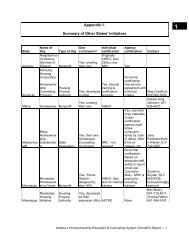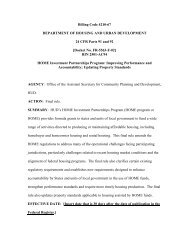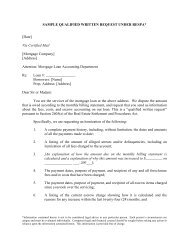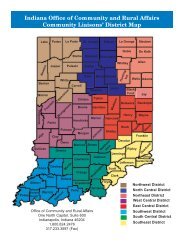FINANCIAL ASSESSMENT Joe Sample
FINANCIAL ASSESSMENT Joe Sample
FINANCIAL ASSESSMENT Joe Sample
Create successful ePaper yourself
Turn your PDF publications into a flip-book with our unique Google optimized e-Paper software.
IntroductionBENEFIT OF <strong>FINANCIAL</strong> <strong>ASSESSMENT</strong>SThe benefit of the financial assessment is to help you gather the facts so you can take anhonest look at your finances. This should help you to gain more enjoyment from your incomeand realize your financial goals.THE <strong>FINANCIAL</strong> <strong>ASSESSMENT</strong> REPORTThe financial assessment report is an analysis of the financial data you entered. The accuracyof the report is predicated on correct information. If you find any errors, correct the informationand print an updated report.The financial assessment report includes:Net Worth StatementNet Worth AnalysisCash Flow StatementCash Flow AnalysisIncome Tax AnalysisSavings AnalysisFinancial Ratio AnalysisCredit Use AnalysisDebt SummaryMonthly BudgetBudget AnalysisCredit Card Evaluation (if applicable)UPDATESBecause your finances constantly change, you should update your financial information often.When you pay off debt, increase your savings, decrease your expenses or have any otherfinancial changes, update your record.DISCLAIMERThe financial assessment report is for general and educational purposes only. It is not intendedto be, and should not be construed as, legal, tax or investment advice.Your file will remain stored in our secure database and you may continue to use it to updateand change your information as often as you like.We hope that this report is useful for your future financial planning.
Net Worth Statement !"#$!%&'#$!%())'% )!%! !*+",-%!#%#&.(%'/$!#%#0% 1% 2#34! &5'67&"58640$"0%#%&1#(9%0%#%
1 0#:%#"9%0 %%&$!%8# (1 1% .'#%)%70%,#",%# #%#,#&;
NET WORTH ANALYSISOBJECTIVEYour primary objective is to understand your current financial condition. The Net WorthStatement is an important financial document. It shows what you own (assets) minus what youowe (liabilities) and what remains (net worth). The Net Worth Statement is a snap shot of yourwealth at this point in time. Your goal is to develop a long-term financial plan that will increaseyour net worth. The Net Worth Statement is sometimes called a Balance Sheet. YOUR CURRENT STATUSYour assets minus your liabilities equal your net worth. At this time, your are not buildingwealth.Your current assets are: $18,189.00Your current outstanding debts (liabilities) are: $19,000.00Your net worth is: $-811.00POTENTIAL SOLUTIONS<strong>Joe</strong>, you currently have $19,000.00 in outstanding debt. You should focus on paying offdebt. It is recommended that you update your Net Worth Statement annually to monitoryour progress
,- $".>7 .!?##".!#&9%"(.0%#%1#?13#%#"# !#%.3#%&$ #(# !%/4%%*###% -#$!#%#0%0 %#9% '/01+++*++2 ;
0%#%%#8!%#9%0%#%$!% #)* 3*# 2/*# '/01+++*++'4145(*0)'+*++67 #,2.27;#%#" !&0%()%/=!#%4%$!%8# %$!%8# 4!2#34! %4!*#8# #%4!"@&0%4!(0 %%;
27&!- %#">%7@&; ()#%/2# &!/(')1:(3*(0,.-#2!"0%!%&'7;'9!% ,.(&'01)::*(5 0#%%#72#-"9# 70#&1'#7; &('90+*++.!7;
6 #67 )*# 273*#6/*6 '3(1/0)*5('391903*4:'5(+*++'))(*9:
OBJECTIVECASH FLOW ANALYSISYour primary objective is to account for all the money you earned (income) and all the moneyyou spent (expenses). The Cash Flow Statement shows your cash inflows (income) and yourcash outflows (expenses). It is a historical record of your income and expenses over a certainperiod of time, usually a year. Your goal is to make sure your income is more than yourexpenses. Your Cash Flow Statement is perhaps the most important financial statementbecause it allows you to measure your standard of living against your ability to maintain it. TheCash Flow Statement is sometimes called an Income and Expense Statement. YOUR CURRENT STATUSYour cash flow statement containsthree sections:Income: shows the money youreceived over the periodExpenses: shows how you spent themoney.Net Gain: shows the amountremaining after all expenses andliabilities are paid.Net Loss: shows your expensesexceed your income.Your annual gross income is: $35,000.00Your disposable income is: $28,351.48Your annual expenses are: $27,752.69Your annual debt is: $480.00Your net gain/loss is: $118.79POTENTIAL SOLUTIONS<strong>Joe</strong>,You are successfully managing your income and expenses.
<strong>FINANCIAL</strong> RATIO ANALYSISOBJECTIVEYour primary objective is to monitor and measure your financial health. Financial ratios helpyou to analyze your finances in specific financial areas. Financial ratios are tools you can useto make wiser financial decisions. Your goal is to stay within the financial ratio benchmarks. YOUR CURRENT STATUS Your Basic Liquidity ratio is:0.08 Your Debt ratio is:11% Your Housing ratio is:27% Your Housing + Debt Ratio is: 38%Your basic liquidity ratio shows the number of months you will be able to pay your monthlyobligations if you should lose your income. You should have enough money in youremergency fund to cover you for 6 months. Your basic liquidity ratio should be 6.0. Your debt ratio is the percentage of your monthly income that you spend on your debtobligations. Your debt ratio benchmark should not exceed 10%.Your Housing ratio is the percentage of your gross monthly income that you spend on yourmonthly mortgage or rent payment. (Mortgage payment includes principle, interest, taxes andinsurance.) Your Housing ratio benchmark should not exceed 30%.Your Housing + Debt ratio is the percentage of your gross monthly income that you spend onyour monthly mortgage or rent payment and your debt obligations. Your Housing + Debt ratiobenchmark should not exceed 40% POTENTIAL SOLUTIONS<strong>Joe</strong>,In the event of lost income, you would not be able to pay your monthly expenses.You should work on increasing your emergency fund (cash reserve). Refer to yourSavings Analysis report for more suggestions.Your Debt Ratio is 11% of your income. Your debt ratio should be in 10% - 12% range.You should work on decreasing your debt. Refer to your Debt Summary report.Your Housing ratio is in a comfortable range.Your Housing + Debt ratio is in a comfortable range.
SAVINGS ANALYSISOBJECTIVEYour objective is to evaluate your current savings and develop a plan to keep a part of whatyou earn. Savings are critically important to your current financial well-being, future prosperityand financial independence. Financial goals need money to materialize.YOUR CURRENT STATUSYou contribute $0.00 per year to your 401(k).You currently have $0.00 in investment assets.You save $0.00 per year.You currently have $189 in monetary assets. (This is your cash reserve.)POTENTIAL SOLUTIONS<strong>Joe</strong>,RetirementMost Americans can no longer count on their employers or the government to provide forthem during retirement. You must have a retirement account and contribute regularly.The amount you contribute will play a key role in assuring a comfortable retirement. Aretirement account is a must!Emergency FundYou do not have a sufficient cash reserve. Remember to pay-yourself-first! Based on your current income and expenses, your cash reserve should be $14,116.34. You need an additional $13,927.34.A cash reserve should have six months' living expenses and you should only tap into itwhen true emergencies occur. A cash reserve ensures that you will be able to pay yourliving expenses and debt in the event of an emergency or other unexpected expense.Unexpected expenses can set you back from reaching your financial goals.
CREDIT CARD USE ANALYSISOBJECTIVEYour primary objective is to review how you currently use credit cards. Overusing credit cardsis the number one cause of financial problems.YOUR CURRENT STATUSAn analysis of your credit card use reveals the following: You have 2 open credit card(s). Your total debt from credit cards is: $2,000.00 Your credit card debt is at a(n) Excellent level. Average Interest Rate: 16.5% Your total credit limit is: $7,500.00POTENTIAL SOLUTIONS<strong>Joe</strong>,You are handling your credit well, keep up the good work!
CREDIT CARD EVALUATIONName: <strong>Joe</strong> <strong>Sample</strong>Date: Nov 20, 2007)*6Current Balance: $1000.00 Credit Limit: $5000.00Current Interest Rate: 18%Current Monthly Payment:$20.00 #Your current repayment method will pay off this debt in 7year(s) and 10 month(s) and you will pay a total of $862.24in interest payments." !.#Debt Reduction StrategyYour monthly budget indicates that you have $9.9 permonth, available after expenses.You have a sufficient amount of money to increase yourmonthly payment. Increasing your monthly payment to$22.97 will pay this account off in 6 year(s) and 0 month(s)and you will save $229.18 in interest payments.)Reduce Interest Rate StrategyYour current interest rate on this credit card is 18%.Reducing your interest rate to 14% will pay this account offin 6 year(s) and 4 month(s)and you will save $352.67 ininterest payments.Note: Creditors are more likely to negotiate an interest ratereduction if you are making your payments on time.Increase Credit Score StrategyYour current balance on this account is 20% of your creditlimit.This level of use is at a very comfortable range and has apositive impact on your credit score. Continue to plan eachpurchase carefully to maintain positive credit score.
3*;Current Balance: $1000.00 Credit Limit: $2500.00Current Interest Rate: 15%Current Monthly Payment:$20.00 #Your current repayment method will pay off this debt in 6year(s) and 7 month(s) and you will pay a total of $579.12 ininterest payments." !.#Debt Reduction StrategyYour monthly budget indicates that you have $9.9 permonth, available after expenses.You have a sufficient amount of money to increase yourmonthly payment. Increasing your monthly payment to$21.48 will pay this account off in 5 year(s) and 11 month(s)and you will save $71.10 in interest payments.)Reduce Interest Rate StrategyYour current interest rate on this credit card is 15%.Reducing your interest rate to 14% will pay this account offin 6 year(s) and 4 month(s)and you will save $69.55 ininterest payments.Note: Creditors are more likely to negotiate an interest ratereduction if you are making your payments on time.Increase Credit Score StrategyYour current balance on this account is 40% of your creditlimit.This level of use is at a comfortable range and has a positiveimpact on your credit score. You should limit your use of thiscard and plan future purchases carefully.
Total Balance: $2,000.00 Credit Limit: $7,500.00Avg. Interest Rate: 16.5% Monthly Payments: $40.00Your Current StatusMonths until debt free:94Your Status with Debt ReductionStrategyMonths until debt free:72Total Interest Payments: $1,441.36 Possible Interest Payments: $1,141.08It is possible to pay off your credit card debt 1.8 years sooner!Note: Pay off time assumes you make no additional charges on your credit cards.
DEBT SUMMARYOBJECTIVEYour primary objective is to monitor and measure your debt. The Debt Summary allows you totake a look at ALL debt so that you can see how much you owe. Most people have never seentheir entire debt picture. This review should help you to determine your debt capacity. Debtcapacity is the amount you can reasonably repay given your current income, expenses andliabilities. With this information you can develop a strategic plan to reduce debt.YOUR CURRENT STATUSCredit Card DebtBalance Owed1. JCPennys $1,000.002. Discover $1,000.00Long-term DebtBalance Owed1. Automobile Loan $17,000.00Total Debt: $19,000.00POTENTIAL SOLUTIONS<strong>Joe</strong>,Debt is the primary reason most people don't meet their financial goals. Therefore, the mostadvantageous "investment" you can make is to pay off debt. Your net worth will increase asdebt is paid down and you can then use the money from debt payments to save.The first step to relieve debt and reach your financial goals is to take a look at how muchmoney is coming into the household and how much money is going out. Your Cash FlowStatement, used in conjunction with your Budget Analysis report can help you identify areasyou can cut spending, even if temporarily. A realistic budget is your best weapon againstoverspending and paying down your debt.Additionally, you can use your Credit Card Evaluation report for more suggestions on payingdown your credit card debt.
INCOME TAX ANALYSISOBJECTIVEYour primary objective is to have a year-round tax plan that will reduce the amount of federaland state income taxes you pay. Taxes make up to 10 to 35 percent or more of your income.YOUR CURRENT STATUSHighlights of your 2006 YEAR income taxes.Gross Income $35,000.00Qualified RetirementContributionAdjusted GrossIncome$0.00$35,000.00Taxes Due<strong>Joe</strong>,Federal $4,081.87State $1,203.76FICA $1,063.37Medicare $299.51Total Taxes Due $6,648.51POTENTIAL SOLUTIONSThinking about ways to save money at tax time is too late! You need year-round tax planning.You should estimate what your annual income and tax payment will be then you can exploretax savings strategies such as:-Putting money in a qualified retirement plan could be a good tax reduction strategy.-Take all your legal deductions.-As your income increases, the importance of a tax planning strategy increases.-Reduce your tax liability when possible.
.! $".>7 .!?##".!#&9%//.0%#%1#?13#%#"# !#%.3#%&$ #(# !%/4%%*###% -#$!#%#0%0 %#9% '31:)4*492 ;
0%#%%#8!%#9%0%#%$!% #)* 3*# 2/*# 67 #'31:)4*49'005*+5'+*++'31/43*438$,2.27;#%#" !&0%()%/=!#%4%$!%8# %$!%8# 4!2#34! %4!*#8# #%4!"@&0%4!(0 %%;
27&!- %#">%7@&; ()#%/2# &!/"""')40*35,.-#2!"0%!%&'7;'9!% ,.&"""'5//*/3 0#%%#72#-"9# 70#&1'#7; /&(""'43*0+.!7;
6 67 )*# 273*#6/* 6 '31/43*43'31/)3*93'5+*++':*:+
BUDGET ANALYSISOBJECTIVEYour primary objective is to plan your spending. A budget, unlike a cash flow statement, is abenchmark. It is a changeable, relatively fluid document that helps you plan. A budget alsocalled a Spending Plan summarizes the total income you plan to receive and spend eachmonth. A successful budget will give you greater control of your money and help you to trackwhether or not you are living within your income limit.YOUR CURRENT STATUSYour monthly income: $2,916.67Your disposable income is: $2,362.62Your monthly expenses are: $2,312.72Your monthly debt is: $40.00$9.90 (Your net gain is the amount of money you have leftYour net gain is:after ALL expenses and debts are paid. This is the moneyyou have to accomplish your goals.)POTENTIAL SOLUTIONSYou have $9.90 left each month to reduce your debt.HousingYour monthly rent is: $800.00Your other monthly housing expenses are: $165.24Your total monthly housing expenses are: $965.24Your total monthly housing cost are 41% of your disposable monthly income.NOTE: Your housing cost are $203.19 above the national average.
FoodYour total monthly food expenses are: $433.32Your total monthly food cost are 18% of your disposable monthly income.NOTE: Your food cost are $103.96 above the national averageAuto-TransportationYour total monthly auto expenses are: $467.50Your total monthly auto cost are 20% of your disposable monthly income.NOTE: Your auto-transportation cost are $11.81 above the national average.ClothingYour total monthly clothing expenses are: $125.00Your total monthly clothing cost are 5% of your disposable monthly income.NOTE: Your clothing cost are $2.36 above the national averageMedical/Dental
Your total monthly medical/dental expenses are: $16.67Your total monthly medical and dental cost are 1% of your disposable monthly income.Your medical and dental expenses are in a good range.27GiftsYour monthly gift cost are: $200.00Your monthly gift expense is 8% of your disposable monthly income.Cable/InternetYour monthly cable/internet cost are: $105.00Your monthly cable/internet expense is 4% of your disposable monthly income.NOTE--The U.S. Department of Labor's Bureau ofStatistics Consumer Expenditure Surveyexpenditure averages are based on surveyedhouseholds. They are NOT the amounts familiesshould spend.









